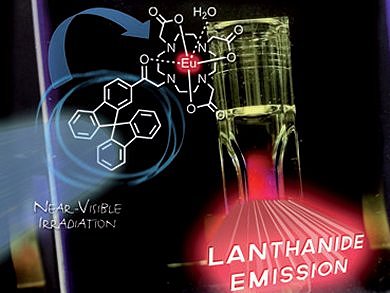High efficiency has been obtained for luminescent probes for biochemical and biomedical applications. However, the possibility to shift the wavelength of excitation from medium UV towards the visible region by using chromophores that absorb light above 350 nm should result in beneficial practical implications.
Lidia Armelao, University of Padova – CNR IENI, Silvio Quici, CNR ISTM Milano, both Italy, and co-workers have developed two series of innovative luminescent lanthanide antenna complexes in which fluorene and spirobifluorene chromophores act as light-harvesting units in the near-visible region. They are covalently bonded to 1,4,7,10-tetraazacyclododecane-1,4,7-triacetic acid (DO3A), a macrocyclic multidentate ligand that acts as a highly effective hosting unit for Ln3+ cations.
The structural organization of the ligands renders the complexes of Eu3+, Sm3+, Dy3+, and Tb3+ highly soluble in aqueous solutions and chemically stable over time. The complexes can be excited well above the threshold value of 350 nm and the luminescence of the Eu3+complexes is clearly detectable at concentrations as low as 10 pM.
Thus, these complexes could lead to the development of new lanthanide molecular probes with higher-emission quantum yields that have the potential to provide new multifunctional molecules for biochemical and biomedical purposes.
- Efficient Luminescence from Fluorene- and Spirobifluorene-Based Lanthanide Complexes upon Near-Visible Irradiation,
Gregorio Bottaro, Fabio Rizzo, Marco Cavazzini, Lidia Armelao, Silvio Quici,
Chem. Eur. J. 2014.
DOI: 10.1002/chem.201305029




